Living Mysteries: This complex beast lurks on lobster whiskers
The pandora’s tiny body is a lean and mean marvel of evolution
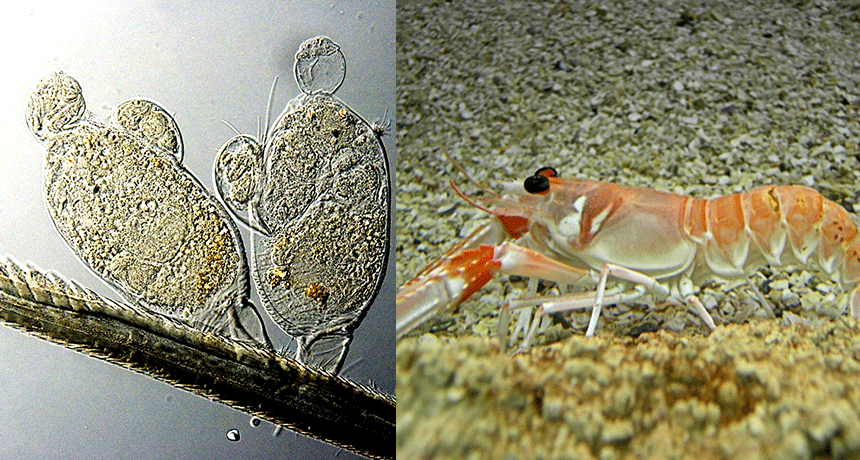
Symbion pandora (left) is a tiny animal that lives on the mouth whiskers of lobsters. Smaller than a grain of salt, it devours leftover crumbs from its host’s meal. Pandora lives on only the Norway lobster (right). At least two other Symbion species reside on other lobsters.
From left: Reinhardt Møbjerg Kristensen; Hans Hillewaert/Wikimedia Commons (CC BY-SA 4.0)
By Douglas Fox
One of the world’s weirdest beasts was discovered hiding on the whiskers of a lobster. It’s called Symbion pandora. And a single lobster can host thousands of pandoras. If you’ve ever eaten lobster, you may even have dined on these critters without knowing it.
The whiskers around a lobster’s mouth, on its underside, are speckled yellow-white. Though teeny, those speckles are actually a vast city of pandoras.
Under a microscope, the individual critters take shape. They hang onto a lobster’s whisker like plump little pears on a tree branch. Each is smaller than a grain of salt. But up close, a pandora appears terrifying — like an angry vacuum cleaner. It has a sucker mouth surrounded by little hairs.
When a lobster eats a worm or fish, these little monsters devour the crumbs. A single blood cell barely squeezes down a pandora’s throat.
A closer look at an individual pandora reveals that it is actually a whole little family. Inside, next to its stomach, is a baby. And sitting on pandora’s back is a pouch that holds two hitchhiking males.
This species is one of the smallest animals known — and the little male is smallest of all pandoras. Its body contains just a few dozen cells. And yet it makes the most of those cells. It has a brain and other important organs.
When it comes to how small an animal can be, “this is really close to the limit,” says Reinhardt Møbjerg Kristensen. He’s a zoologist at the University of Copenhagen in Denmark. “We are down to the smallest, smallest invertebrate [animal] that we have on Earth.” (By invertebrate, he’s referring to animals lacking a backbone. These account for about 95 percent of all animals.)
Pandora shows scientists how evolution can strip a creature’s body down to almost nothing. Yet this tiny body is anything but simple. It is actually quite advanced.
Remote island
Scientists first noticed these little animals on lobsters’ whiskers in the 1960s. No one knew what they were. So Claus Nielsen preserved the animals for future study. He was a zoologist at the Marine Biological Laboratory in Helsingør, Denmark. He took some lobster whiskers, with the creatures attached, and embedded them in clear plastic.
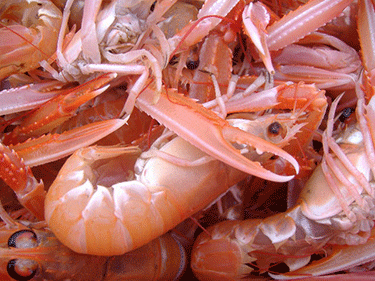
It was not until 1991 that Nielsen handed that plastic to Peter Funch. Funch was a graduate student at the time, working with Kristensen.
Funch would study this animal, nonstop, for the next five years. He took detailed pictures of it, each magnified several thousand times. He traveled to remote islands in the Atlantic Ocean for a month at a time. There, he bought freshly caught lobsters from local fishermen. He trimmed off the creatures’ whiskers and collected live pandoras. Then he watched through a microscope as the little critters ate and grew.
Funch remembers these trips as enjoyable, but a lot of work. He often worked until 3 o’clock in the morning. They were “very, very long days,” he says. “You’re trying to solve this mystery and you’re just totally into it.”
He and Kristensen named this newly discovered animal species Symbion pandora. They named it after Pandora’s box. This little box, in Greek mythology, was a gift from the god Zeus. The box was stuffed full of death, disease and many other complicated problems — just as the little pandora, on a lobster’s whisker, also turned out to be surprisingly complicated, despite its small size.
Baby of the month
Scientists find new species all the time. They usually belong to groups of species that are already known — like a new kind of frog, or a new type of beetle. But this new species, S. pandora, was far more mysterious. It was not closely related to any known animal.
Funch and Kristensen also realized that it has a surprisingly complicated life. For one thing, not all of these animals are alike. Only a few grow up to be “big pandoras” that eat and make babies.
Pandora also reproduces in a weird way. Big pandoras, which are neither male nor female, usually have a baby growing inside them. Each makes one baby at a time. But it can make three different types of babies. And which type it makes depends on the time of year.
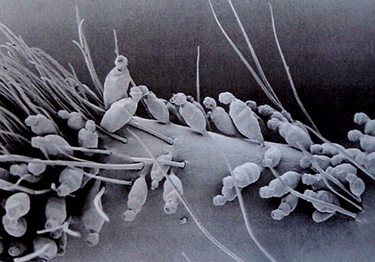
During fall, a big pandora will make copies of itself. The newborns then sit down on another lobster whisker. They open their sucker mouths and start feeding. Pretty soon they start making their own babies.
In early winter, all of these big pandoras start making male babies. As each male is born, it crawls away and finds another big pandora. It glues itself to that big pandora’s back. And then, something strange happens. This glued-down male begins growing two smaller males inside it. Pretty soon, the first male is nothing but a hollow pouch glued to a big pandora’s back. And hiding inside the pouch are two “dwarf males.” These are tiny — just one one-hundredth the size of big pandora. The dwarf males stay inside the pouch, waiting for females to be born.
By late winter, all of the big pandoras have dwarf males waiting on their backs. Now, they switch to making female babies. Funch could tell these babies were females because each had what looked like a big beach ball inside. That “beach ball” was an egg cell — ready to be fertilized by a male.
Funch took several years to figure out the complex story of how pandoras reproduce. By 1998, he had finished his doctoral degree and become a professor of zoology at Aarhus University in Denmark. It would be up to someone else to discover pandora‘s next surprise. That someone was Ricardo Cardoso Neves. He started as Kristensen’s new graduate student in 2006.
Shrinking boy
Neves set out to count how many cells make up the dwarf male’s body. He marked them with a dye that binds to a cell’s nucleus (NOO-klee-us). The nucleus is the bag that holds a cell’s DNA. Each cell has one nucleus, so counting the nuclei (NOO-klee-eye) told him how many cells there were. And the result shocked him.
A tiny mosquito has more than a million cells in its body. One of the world’s smallest worms, called C. elegans, has a body shorter than the thickness of a penny. It has about 1,000 cells. But a dwarf male pandora has just 47.
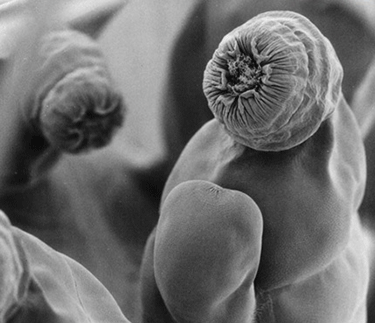
Most of those cells — 34 of them — form its brain, Neves found. Another eight cells make up its glands. Those are small organs that ooze out gooey mucus to help the male crawl. Two more cells form the male’s testes. Testes make the sperm that fertilize a female’s egg. The remaining three cells may help the animal feel its surroundings.
So the adult male is incredibly compact. But as Neves studied it, he discovered an even bigger surprise. The male starts its life with a lot more cells — some 200! As it grows up inside its little pouch, it does the opposite of what most animals do, whether humans or dogs. The body of the dwarf male shrinks in size.
Most of its cells lose their nuclei and their DNA. That DNA is precious cargo. It holds the directions for building a cell. Without it, a cell can no longer grow or repair damage. A cell may live for a while without its DNA — but not for long.
So getting rid of the nuclei is an extreme step. But Neves realized that male pandoras had a good reason for doing this. “They get rid of the nuclei just because they don’t have enough space,” he says.
The males spend most of their life hiding inside the little pouch that sits on the back of a big pandora, he points out. It’s a tight fit. But by losing so much DNA, the male shrinks its body size by almost half. That lets two males fit inside the pouch.
And that’s important because any male not in a pouch will get swept away.
A lobster’s mouth whisker is “a dangerous place to be,” Neves explains. As the lobster eats, its whiskers swish rapidly back and forth through the water. To survive on a whisker, a creature must hold on tight. Any that don’t will get thrown off, like a monkey blown out of a tree by a hurricane.
Big pandoras glue themselves permanently to their whisker. The little dwarf males and females use the big pandoras for shelter. The female stays safely inside big pandora’s body. Males stay tucked in the pouch glued to a big pandora’s back.
Funch thinks that the males emerge only once, when it is time to mate. One day in 1993, he was watching a big pandora with a baby female inside its body. Suddenly, the female was moving. She wiggled out of her usual chamber and into big pandora’s gut. The gut is the tube that carries digested food from the stomach to the anus, where the poop comes out.
Young mother
As Funch watched, the big pandora’s muscles squeezed around its gut and pushed the female through — the same way it squeezes out poop. Slowly, the female emerged out of the anus.
The female’s back end came out first. Sitting inside her back end was the big, round egg cell. It was ready to be fertilized by a male. And of course the two males were waiting right there in their pouch.
Funch never quite saw the animals mate. But he has an idea about what happened next. He thinks the two males burst out of their shelter. One mates with the female as she was being born. So by the time she was all the way out, her egg is already fertilized. She then can glue herself to another whisker and let the baby inside her grow.
In this situation, Funch and Neves say, it makes sense that the male is so small. He has no stomach or mouth because those would take up too much room in the pouch. He doesn’t need to live longer than a few weeks. And most of that short life is spent waiting, saving energy. His life has one purpose: Reach the female. Once he mates, he can die. Having two males in the pouch ups the chance that one will succeed.
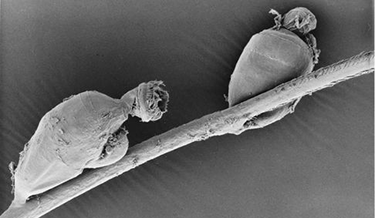
There are other cases where evolution has produced dwarf males. One tiny stinging wasp called Megaphragma (Meh-guh-FRAG-muh) is only two tenths of a millimeter long (less than one one-hundredth of an inch). It is actually smaller than a single-celled amoeba (Uh-MEE-buh). The male starts out with about 7,400 nerve cells. But as it matures, it loses the nuclei and DNA from all but 375 of those cells. This male lives only five days.
But the pandora dwarf male, with only 47 cells, slims down to an even greater extreme. It “is something unique in the animal kingdom,” says Neves. “It’s a fantastic organism.”
Pocket watch
Even a big pandora is smaller and has fewer cells than just about any other animal. But it would be a mistake to call it primitive. Consider a pocket watch. It’s smaller than a grandfather clock. But is it simpler? The pocket watch’s small size actually makes it more complicated. Every gear and spring has to fit perfectly inside its small case. The same is true for the pandora. This animal, says Kristensen, “must be very advanced.”
Evolution can sometimes turn small, simple bodies into large and complicated ones. That’s what happened with apes and humans over the last 20 million years. Our bodies, brains and muscles got bigger.
But just as often, evolution pushes animals the other way. It pushes them toward having weaker bodies, smaller brains and shorter lives.
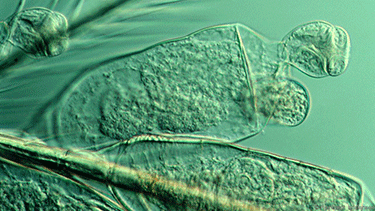
Evolution is all about surviving long enough to produce offspring. And sometimes the best way to do that is to keep bodies small and compact. With pandora, the species’ evolution was shaped by its need to survive a terrible disaster that happens every so often.
Once or twice per year, the entire pandora city dies. This happens because the lobster sheds its shell — including its mouth whiskers. On that day, the entire city of pandoras that was glued to the whiskers now drops to the dark seafloor. Without any of their host’s leftovers to eat, these pandoras starve.
Life boats
Pandora’s odd life style evolved so that it could produce as many babies as possible to survive this disaster. Big pandoras stay glued to a lobster’s mouth whiskers. They eat and use the energy in a lobster’s food scraps to make little males and females, each in their own season. And big pandoras keep their offspring together so that they can mate — and produce a different type of baby. One that will survive.
After the female emerges with her fertilized egg, she glues herself to another whisker. The baby grows inside her. Before that baby is even born, says Funch, it “eats its own mother.”
By the baby’s birth, its mother is nothing but a hollow husk. From its mother, the baby gains enough energy to grow strong muscles. Unlike the big pandora, and unlike the male and female that mated to produce it, this baby is actually a strong swimmer.
Such strong little swimmers leave the dying pandora city. They are like thousands of life boats fleeing a sinking ship. They swim until a few lucky ones find a new lobster. There, they glue themselves onto a mouth whisker. They now change shape, morphing into new big pandoras. They grow mouths and stomachs. They begin to eat and to make babies. So begins a new pandora city.
This “is just an amazing group of organisms,” says Gonzalo Giribet. He’s a biologist at Harvard University in Cambridge, Mass. He studies unusual spiders, sea slugs and other creepy crawlies. He has watched with great interest as the pandora story has unfolded over the last few years.
Pandoras show scientists how evolution can solve common problems in surprising ways, he says. “It’s almost like a great piece of art.”
Pandoras have many lessons to teach scientists. But the greatest might be not to overlook what’s in plain sight. This animal was living in a place that people thought they knew well: on lobsters that people eat every day. “Imagine how ridiculous it is,” says Giribet. “It teaches us about biodiversity, and how little we know.”







